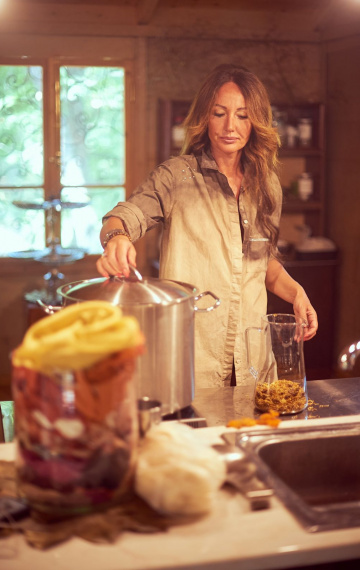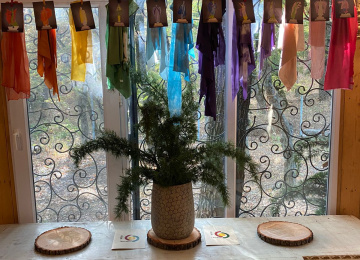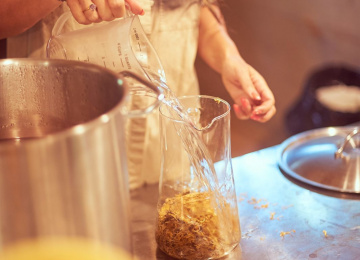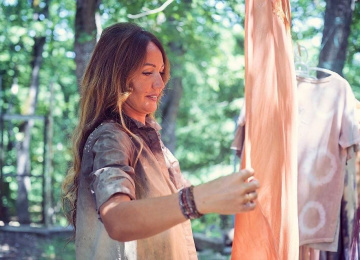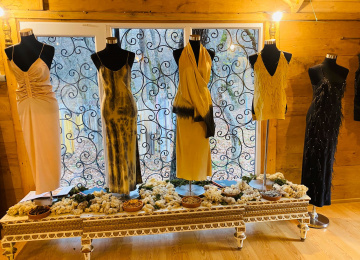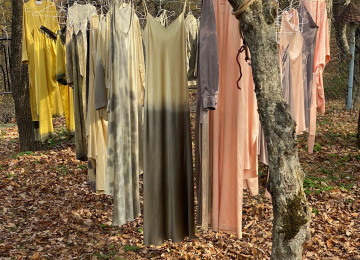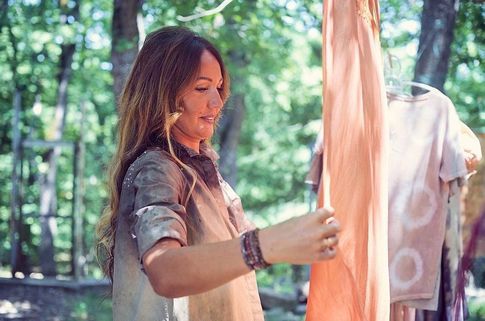
The fabric-dyeing house in Kiketi, just over 30 kilometres away from the Georgian capital of Tbilisi, is a place where the magic happens.
The wooden walls of this well-lit, modern cottage are covered with colourful samples of fabric, with vibrant colours ranging from deep purple to warm orange and light pink. The finished fabrics are draped from the branches of a small tree, which forms part of the cottage interior.
This is the first fabric-dyeing house of an environmentally and socially conscious eco-textile startup called Colors of Caucasus, which is run by Nino Ioseliani, a well-known entrepreneur in the Georgian fashion industry. The company is a member of the Georgian Apparel and Fashion Association (GAFA), which was established with the support of the Clusters4Development project, funded by the EU and the German Government, being implemented by GIZ under the EU4Business Initiative. With the support of EU4Business, industry clusters help SMEs team up with other businesses to become more competitive.
Old tradition, new ways
When Ioseliani returned to Georgia after having lived in Spain for a number of years, she had a clear plan: to start a company with a higher vision that would also benefit the fashion industry. At that time, she was actively involved in organizing Tbilisi Fashion Week and, in parallel, leading her own fashion and marketing enterprise.
“Once I saw how clothes were made in Georgia, I understood that the industry does not have a complete supply chain,” Ioseliani says.
“Designers had to buy fabrics abroad, bring them to Georgia, make clothes here and then sell collections,” she says, noting that none of the fabrics were made in Georgia.
Meanwhile, as an active fashion entrepreneur, she always heard from international buyers that they expected to see something unique from Georgia – the country that symbolizes the entire South Caucasus region. This got her thinking about creating an innovative product that would be sold both locally and internationally.
“Do local, be global,” she remarks, referring to the famous saying. Ioseliani started doing research and took a deeper dive into the issue, delving went way back in history. Specifically, she discovered that before the beginning of the 19th century, Georgians used to dye wool and silk using only natural ingredients such as minerals and plants. Later as chemical dyes came to dominate the industry, this old tradition had been lost.
So Ioseliani decided to update Georgian dyeing recipes and create a unique natural palette of Caucasian colors, based on ancient knowledge, reviving an old tradition of environmentally friendly dyeing.
But she could not do it all alone.
Her search for experienced partners took her back to Spain, where she found an elderly couple living in the mountains who have been learning the old traditions of fabric dyeing for over 20 years. They modernized the old technology and transformed it into a scientific process. After combining Ioseliani’s ancient Georgian recipes with the couple’s international knowledge and experience, they finally started to dye fabrics. These first experiments have now become the basis of a successful business.
“But it didn’t happen in a day,” Ioseliani explains. “I had the idea back in 2014 and created the company five years later.”
Since then, the Colors of Caucasus enterprise has opened a dyeing house in Kiketi, where Ioseliani and her employees hand-dye cotton, silk, and linen using plants and minerals found in the Caucasus region. Most of the plants also have medicinal use and lend lustrous colours to the natural fibers.
“We get each color from a different plant, and use various techniques for processing the fabric,” Ioseliani says. “We use a scientific method, in which you have to measure the acidity and temperature. As a result, once we achieve a particular colour, we can then recreate it. That’s crucial when you collaborate with brands and designers. They tell you what colour they want, and that’s the one you have to get after dyeing.”
At first, employees at the company only dyed silk and didn’t know how to work with other fabrics. But Ioseliani had bigger plans and, luckily, the Clusters4Development project and GAFA showed to support. After Ioseliani underwent some training in Spain, her company also started to work with cotton as well.
“Our work has evolved, because today we dye cotton, silk, and linen, and this was possible with EU4Business support implemented by GIZ,” Ioseliani says.
Later, Colors of Caucasus collaborated with different designers from the association, including the world-acclaimed Georgian brand INGOROKVA, and presented an environmentaly friendly capsule collection at the TRANOÏ Trade Show in Paris, in the sustainable fashion section.
“With support from GAFA and EU4Business, we’re introducing our collections to the European market,” Ioseliani says, noting that her company has collaborated with many famous designers, and created pieces that are now sold across Europe, the United States, and Canada.
GAFA now has over 30 members, including textile manufacturers, fashion designers, and clothing factories that together employ over 1,000 Georgians. GAFA aims to represent, promote and support Georgian apparel and fashion companies by improving their competitiveness in the local and international markets, and by providing apparel producers, independent brands, and designers with the tools and skills that will allow them to be their most competitive in terms of sustainable production, product quality, fashion design, skilled labor, and international branding.
Knowledge as a driving power
The fashion industry produces high levels of environmental pollution, with tons of the chemicals it uses being poured into rivers, seas, and oceans around the globe. For years, Ioseliani has been an advocate of sustainability in fashion, and her mindset was later translated into her own company’s mission.
“Right from the beginning, my goal was to create a system that wouldn’t depend on industrial equipment,” Ioseliani says. “Instead, use human resources and invest in people as much as possible. Yes, the fabric itself can be good for the environment and one's health, but we also wanted the entire dyeing process to be sustainable as well.”
For Ioseliani, the idea of investing in people led to her opening a teaching center in Tbilisi where students would learn environmentaly friendly dyeing techniques. The curriculum covers both theoretical and practical experience, preparing future professionals to share their new skills as they finish their studies.
“Then they can go to regions and spread the knowledge to others,” Ioseliani explains. She says the dyeing house in Kiketi is just the beginning – she wants to open such buildings in regions across Georgia, and further develop the environmentaly friendly dyeing industry. The project would also focus on engaging more women and creating jobs for them across the country.
“In the time you’d need to teach one person at the workplace, you can teach five at the center,” Ioseliani says. “When you’re on a mission to develop a new industry, it’s important to start with a thorough education.”
“Otherwise, you won't succeed.”

